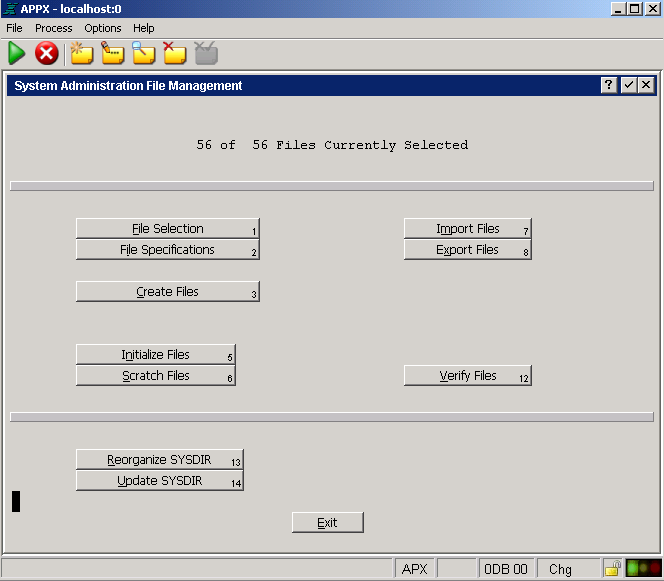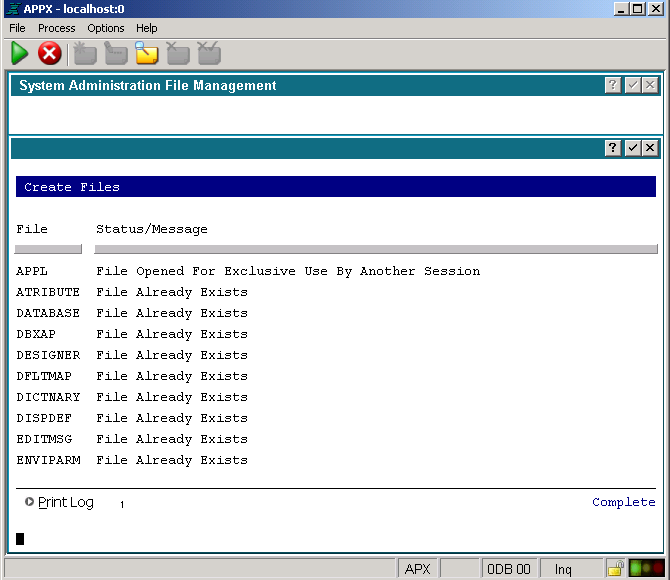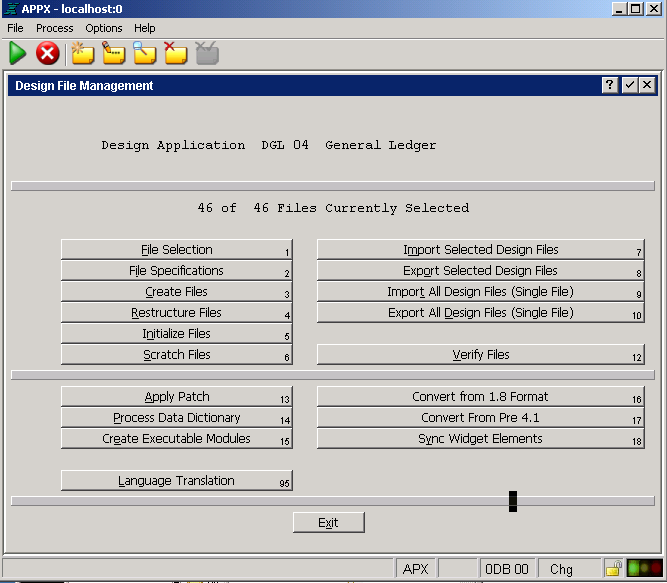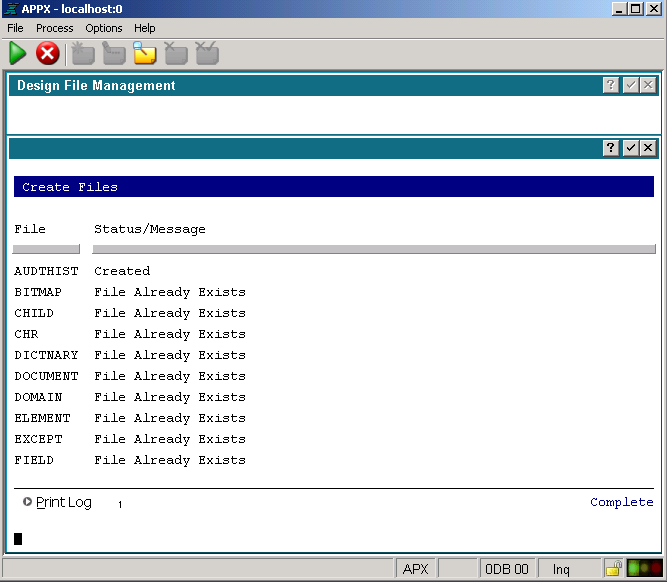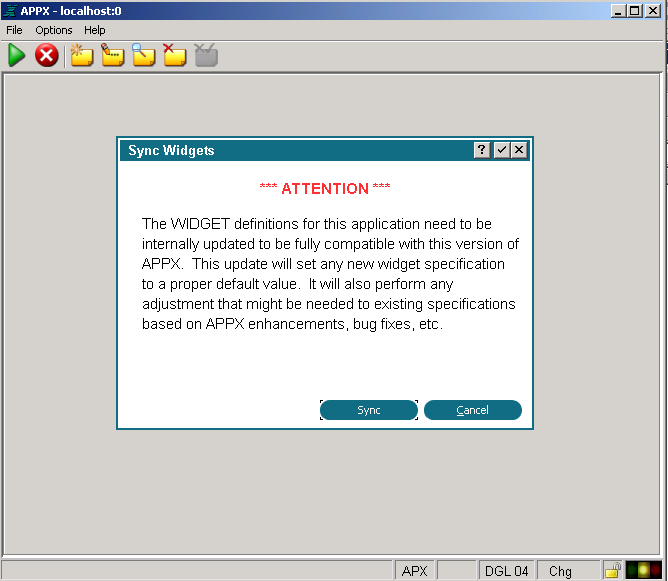
Difference: APPX600UpgradeInstallation (2 vs. 3)
Revision 32018-02-23 - JeanNeron
| Line: 1 to 1 | ||||||||
|---|---|---|---|---|---|---|---|---|
APPX 6 Upgrade Instructions | ||||||||
| Line: 16 to 16 | ||||||||
The basic approach we will use for upgrading is:
| ||||||||
| Changed: | ||||||||
| < < |
| |||||||
| > > |
| |||||||
| ||||||||
| Changed: | ||||||||
| < < |
| |||||||
| > > |
| |||||||
| ||||||||
| Added: | ||||||||
| > > |
| |||||||
| This approach allows you to maintain your existing 5.x installation while migrating/installing Release 6.0. You can test Release 6.0 independently of your existing 5.0 installation. When you are ready to switch you just need to refresh the end user data. The entire process may take a few hours, depending on the amount of data involved. Users can continue to work with your Release 5.0 applications and data while you are migrating, subject to the usual requirement of not copying files that others are actively updating. | ||||||||
| Line: 44 to 45 | ||||||||
| ||||||||
| Changed: | ||||||||
| < < | 3. Run the migration for your System Administration files | |||||||
| > > | 3. Run the migration utility for your System Administration files | |||||||
| Before migrating your System Admin files, you should verify the integrity of the files and correct any errors. The Verify step can be found in System Administration -> System Setup -> System Administration File Management -> Verify Files. Correct any errors before proceeding. | ||||||||
| Line: 55 to 56 | ||||||||
| Click the 'Convert' button to proceed. A report will be produced showing the files that were converted. If any errors are shown, fix them before continuing. The conversion step creates a new set of System Administration files in Release 6.0 format. These are located in $APPXPATH/6SA/6SA/Data. | ||||||||
| Added: | ||||||||
| > > | 4. Install the migrated System Admin files in your new 6.0 installation | |||||||
| You are now ready to install the new System Administration files in your Release 6.0 folder. Follow these steps: | ||||||||
| Changed: | ||||||||
| < < |
| |||||||
| > > |
| |||||||
| ||||||||
| Changed: | ||||||||
| < < |
| |||||||
| > > |
| |||||||
| ||||||||
| Line: 76 to 78 | ||||||||
| If you changed your 'appx.env' file, log off & on again. Check your System Administration files to make sure everything was migrated correctly, i.e., Users, Printers, Forms, Applications, Databases, etc. If all is well, continue with migrating your Applications. | ||||||||
| Changed: | ||||||||
| < < | Preliminary Tasks
Convert Your System Administration Files | |||||||
| > > | 5. Run the migration utility for your applications | |||||||
| Changed: | ||||||||
| < < | The first step of upgrading your APPX 4.2.a installation to APPX 5 is to convert your System Administration files to the new APPX 5 format. The System Administration files for APPX 4.2.a are not compatible with APPX 5 and must be converted to the APPX 5 format. Follow the directions below to convert your System Administration files. | |||||||
| > > | You are now ready to begin migrating your applications. This is a good time to review your applications and decide which ones need to be migrated. For example, it's possible you have old applications that are not used any longer. | |||||||
| Changed: | ||||||||
| < < | Configure the Upgrade Application | |||||||
| > > | Once you have decided which applications you will migrate, you should run 'Verify Files' on each application and address any errors. | |||||||
| Changed: | ||||||||
| < < | After installing the Upgrade Application, you must run APPX as an APPX System Administrator and configure the Upgrade Application. | |||||||
| > > | When you are ready to proceed run Database 6AD from the main APPX menu: | |||||||
| Changed: | ||||||||
| < < | Add the upgrade application (5SA 00) to the Applications file. | |||||||
| > > | 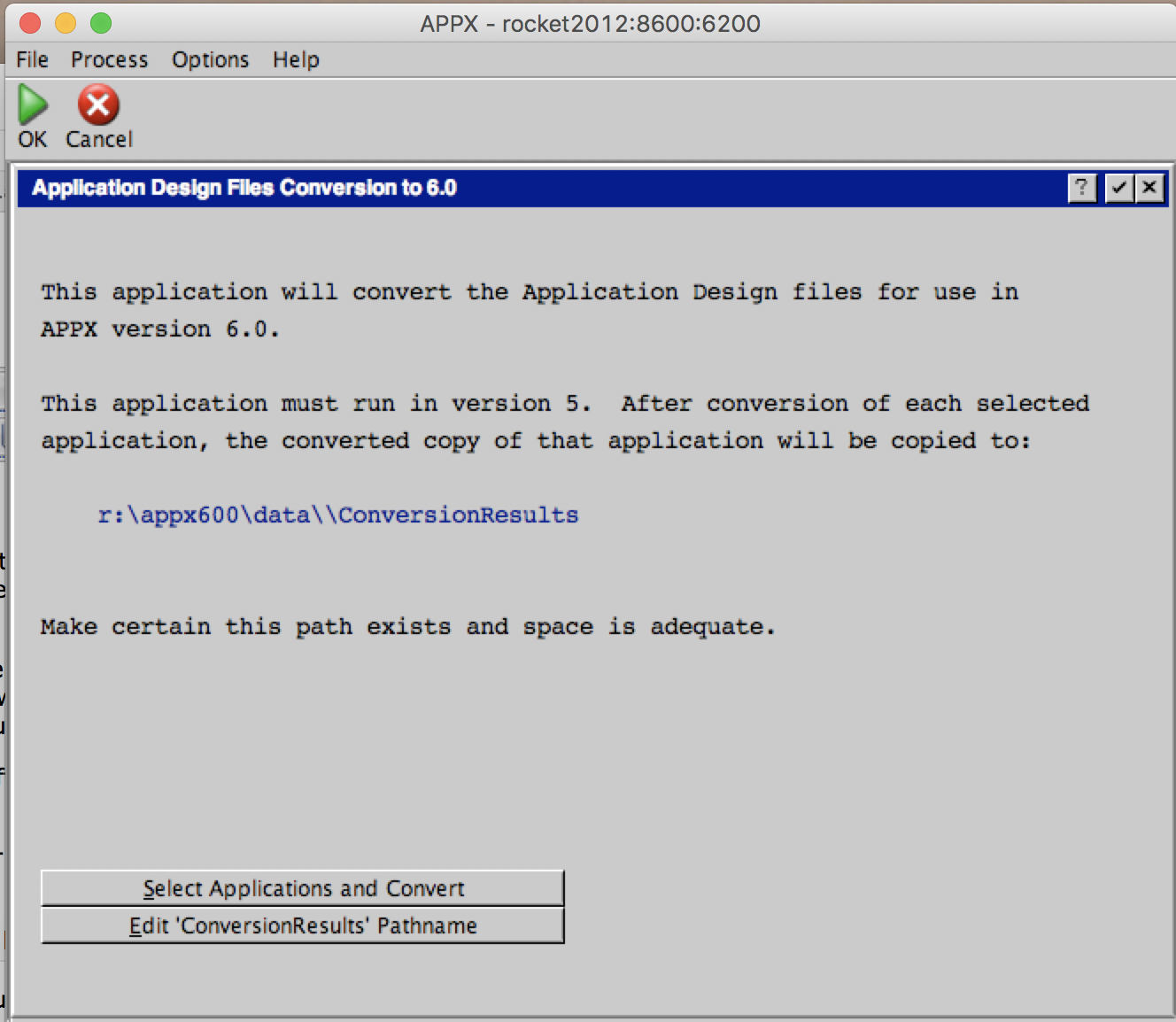 | |||||||
| Changed: | ||||||||
| < < | System Administration (Option 3) > Database / Application (Option 3) > File Maintenance - Applications (Option 1) | |||||||
| > > | The path shown will be different on your system. You can choose a different path by clicking 'Edit ConversionResults Pathname'. | |||||||
| Changed: | ||||||||
| < < | 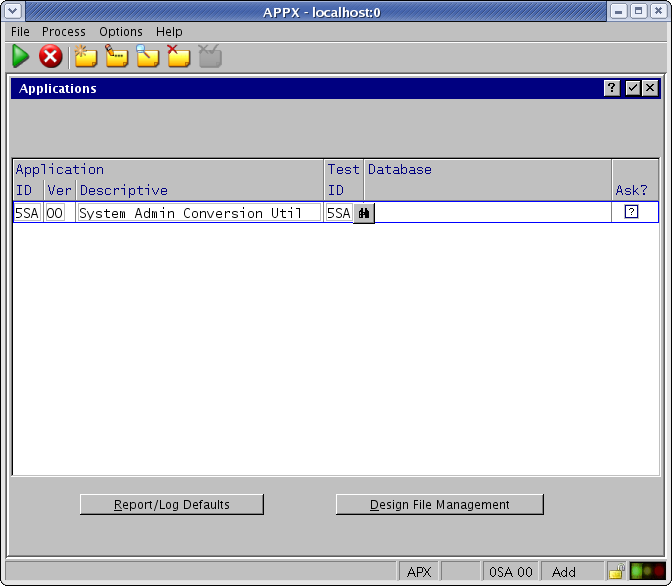 | |||||||
| > > | When you are satisfied with the location, click 'Select Applications and Convert': | |||||||
| Changed: | ||||||||
| < < | Create the Design Files for Application 5SA. | |||||||
| > > | 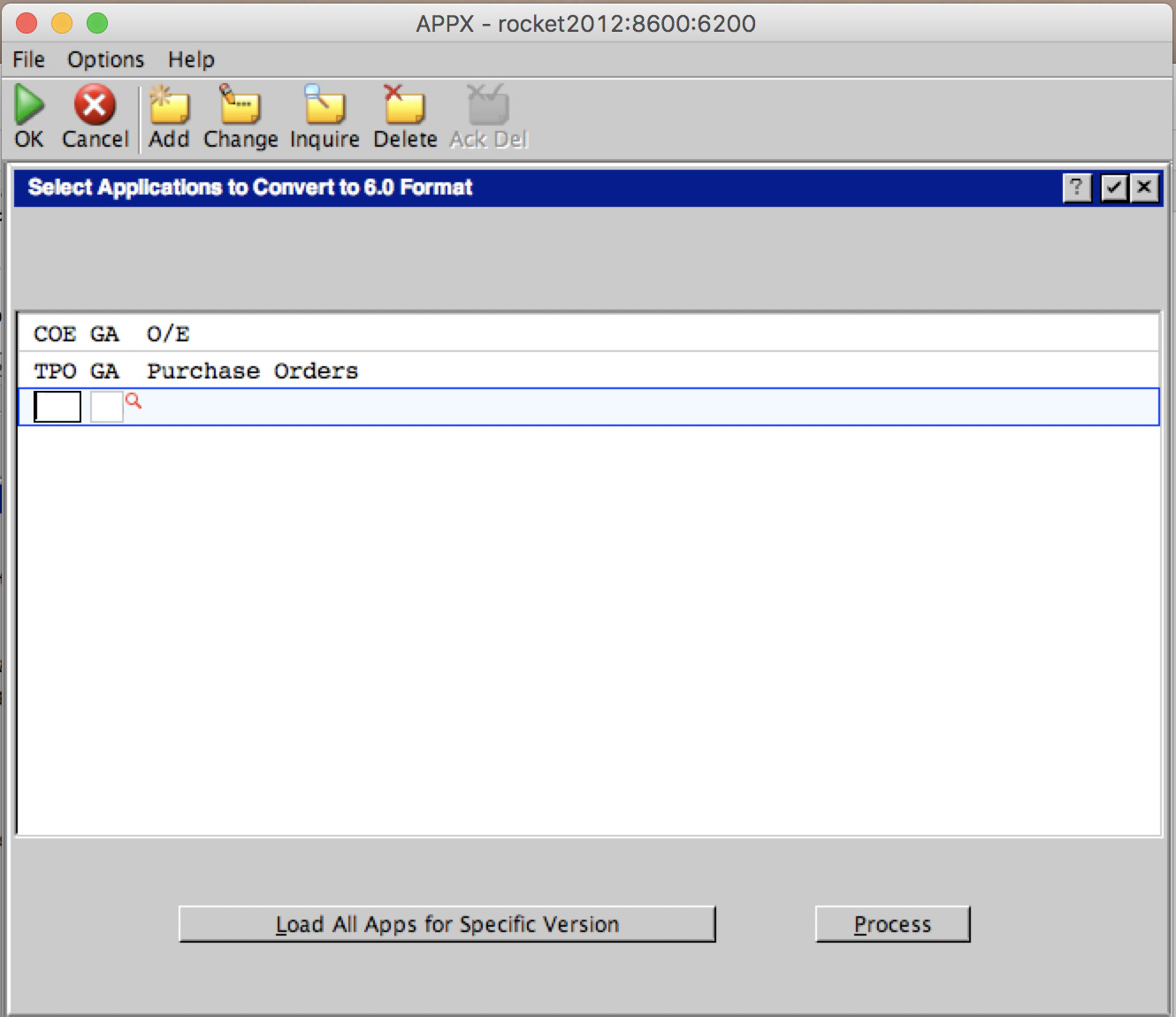 | |||||||
| Changed: | ||||||||
| < < | 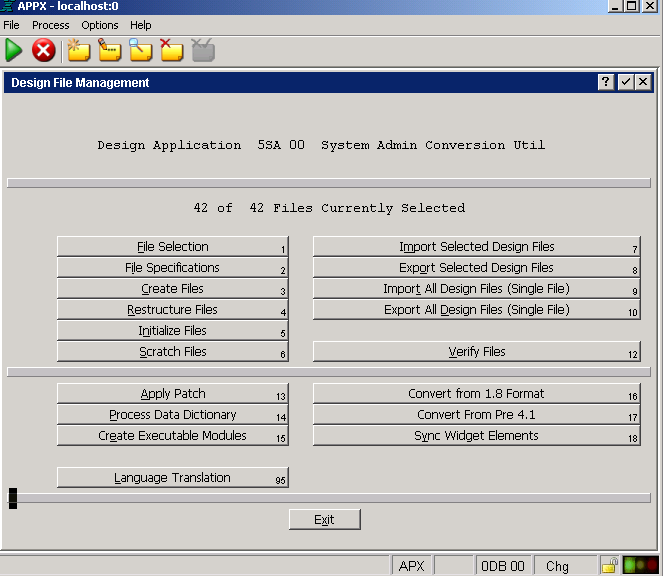 | |||||||
| > > | On this screen you can enter individual Application/Versions, or you can use the 'Load All Apps for Specific Version' button to automatically load all the applications for the entered version. | |||||||
| Changed: | ||||||||
| < < | The Create Files menu selection above should report "File Already Exists" for each file as shown below. If not, the application was not installed in the correct location. Repeat the installation steps above, specifing the correct location | |||||||
| > > | When you are ready to proceed, click the 'Process' button. | |||||||
| Changed: | ||||||||
| < < | 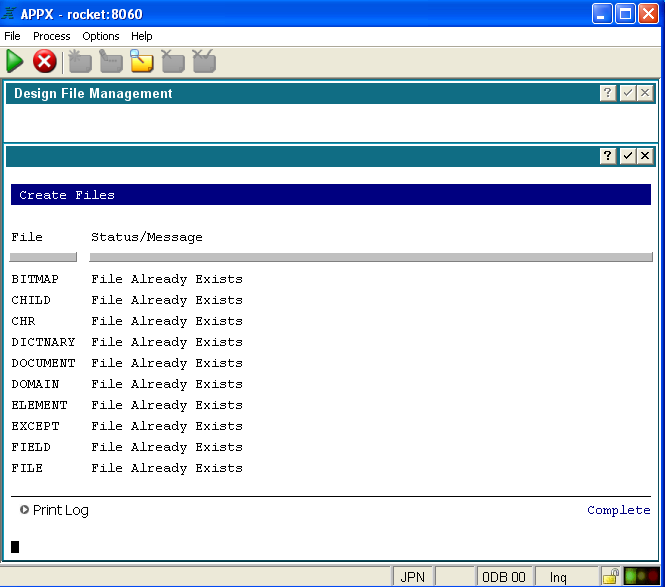 | |||||||
| > > | The applications will be processed and a report produced showing the applications and files that were processed. Check the report for any error messages. Note that not every application uses all possible design files, so the 'FI_STRUCT_NOT_FOUND' message is not necessarily an error. | |||||||
| Changed: | ||||||||
| < < | Add the database (5SA) for the Upgrade Application to the Databases file. | |||||||
| > > | It is not necessary to convert all your applications at once. For example, if you have a test version and a test database, you may want to just migrate those initially. | |||||||
| Changed: | ||||||||
| < < | System Administration (Option 3) > Database / Application (Option 3) > File Maintenance - Databases / Applications (Option 2) | |||||||
| > > | When this step completes, you can proceed to installing the migrated applications in Release 6.
6. Install the migrated applications | |||||||
| Changed: | ||||||||
| < < | 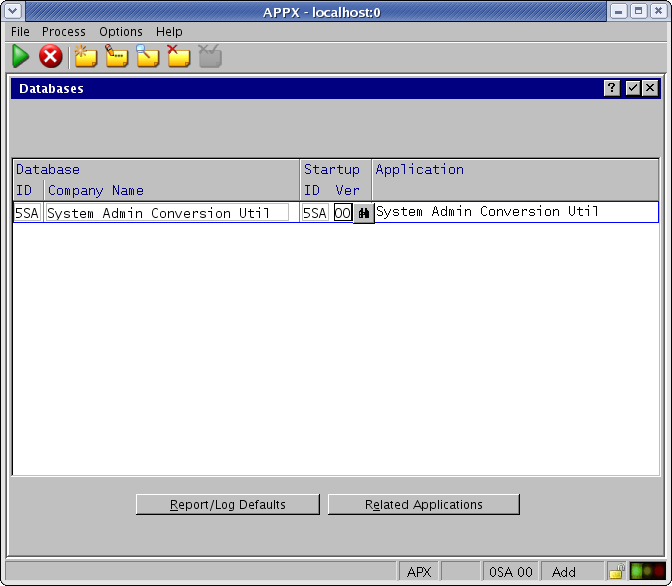 | |||||||
| > > | To install the migrated applications, simply copy the folder(s) from the 'ConversionResults' path to $APPXPATH in Release 6.0. | |||||||
| Changed: | ||||||||
| < < | Run Database Management for the Upgrade Application and Database. | |||||||
| > > | For example, let's assume our conversion results path was R:\appx\data\ConversionResults. We converted 2 applications, both in version GA. The migrated applications will be in R:\appx\data\ConversionResults\GA. Our Release 6 version is installed in R:\appx600new\, so I would copy (or move) the 'GA' folder to 'R:\appx600new\data'. If I converted more than one version at a time, there would be multiple folders in the conversion results folder, and they would all be copied/moved to $APPXPATH in Release 6.0. | |||||||
| Changed: | ||||||||
| < < | 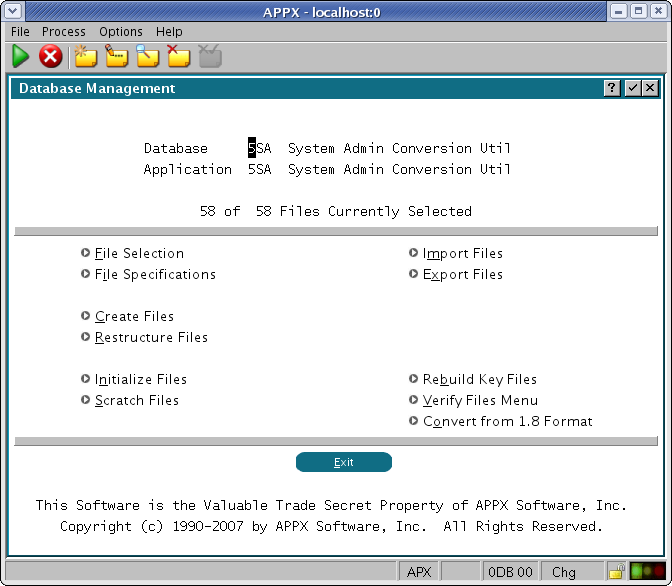 | |||||||
| > > | The migration tool does not copy Resources. If you are using any, you must manually copy the Resource folder from the Release 5 location to the Release 6 location. | |||||||
| Changed: | ||||||||
| < < | Run Create Files. | |||||||
| > > | The migration tool does not create the structure files or process the Data Dictionary. This must be done in Release 6 for every application. | |||||||
| Changed: | ||||||||
| < < | 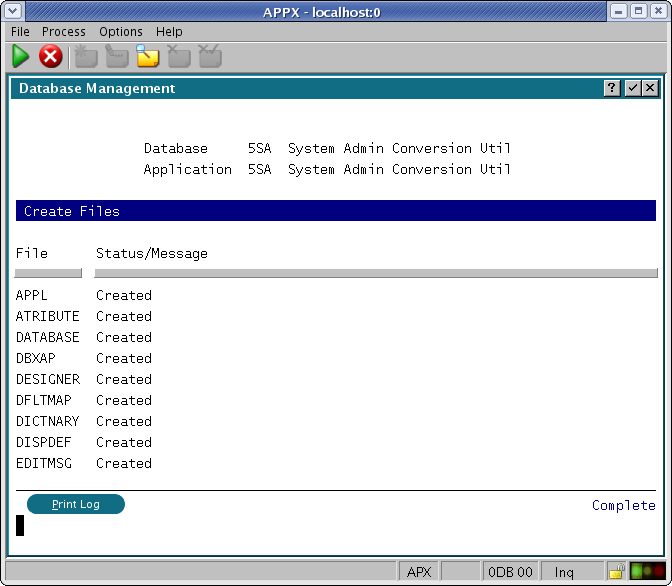
Run the Upgrade Application | |||||||
| > > | The easiest way to do this is to go to 'Applications' in System Administration and select the first migrated application. Then choose 'Design File Management', and from there, run 'Create Files', then 'Process Data Dictionary'. Repeat this for each migrated application.
7. Copy the end user data to Release 6.0 | |||||||
| Changed: | ||||||||
| < < | After configuring the Upgrade Application, you must run the Upgrade Utility to convert your System Administration files. | |||||||
| > > | Next, we must copy the end user data to our Release 6.0 installation. As mentioned previously, the Structure files are completely different between Release 5 and Release 6, so we must create new Structure files in Release 6. | |||||||
| Changed: | ||||||||
| < < | Run an Application (Option 1). 5SA. | |||||||
| > > | If you are using an FMS group to redirect APPXIO files from their standard location, then you will have to change the Release 6 FMS group to point to a different location, otherwise Release 5 & Release 6 will be accessing the same Structure files and that will not work. | |||||||
| Changed: | ||||||||
| < < | 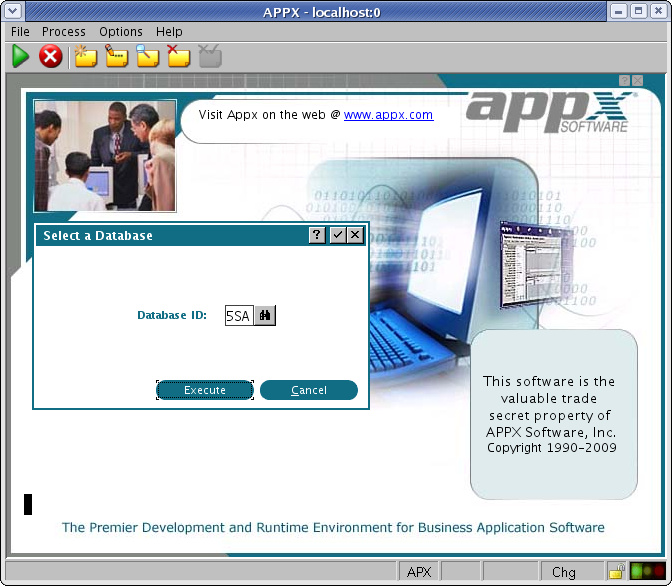 | |||||||
| > > | If you are using an FMS group to point to an RDBMS it will technically work, since each release of APPX has it's own Structure files but this is not recommended. Instead, change the FMS group in Release 6 so that it's files are unique. For example, you could add a prefix to the table naming scheme and then use the RDBMS utilities to copy the existing data to the new naming scheme. | |||||||
| Changed: | ||||||||
| < < | Click on the "Convert" button to run the conversion utility. | |||||||
| > > | Do not copy the 'Struct' folders, or alternatively, delete them after copying. For example, to copy a database '123', we would copy all the files in R:\appx\data\123 to R:\appx600\data\123. After the copy is complete, we would delete all the Struct folders in R:\appx600\data\123. | |||||||
| Changed: | ||||||||
| < < | 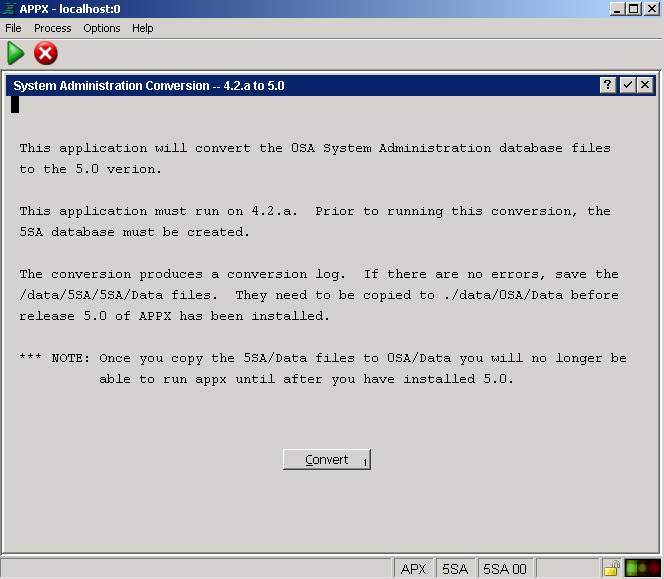 | |||||||
| > > | To create the new Structure files, we have to run 'Create Files' for each application in the database. The easiest way to do this is to go to 'Databases/Applications' in System Administration, choose the Database, then click 'Related Applications'. For each application in the list, click 'Database Management', then 'Create Files. | |||||||
| Changed: | ||||||||
| < < | The conversion utility will create a log. Specify the appropriate disposition options to print the conversion log. | |||||||
| > > | Once this step is complete, you should be able to run your applications under Release 6, subject to the application issues in the next section.
8. Final Tasks | |||||||
| Changed: | ||||||||
| < < | 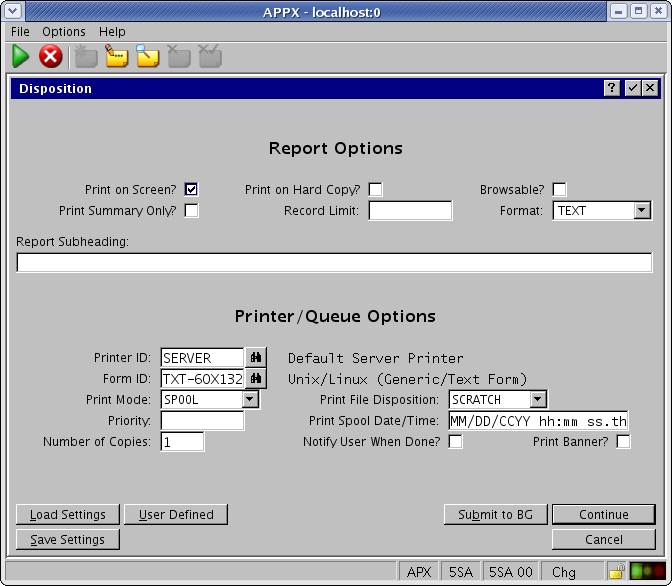 | |||||||
| > > | TEMP fields Unicode | |||||||
| Changed: | ||||||||
| < < | The conversion log will inform you of any problems that may have been encountered while running the conversion utility. | |||||||
| > > | old STREAM | |||||||
| Changed: | ||||||||
| < < | 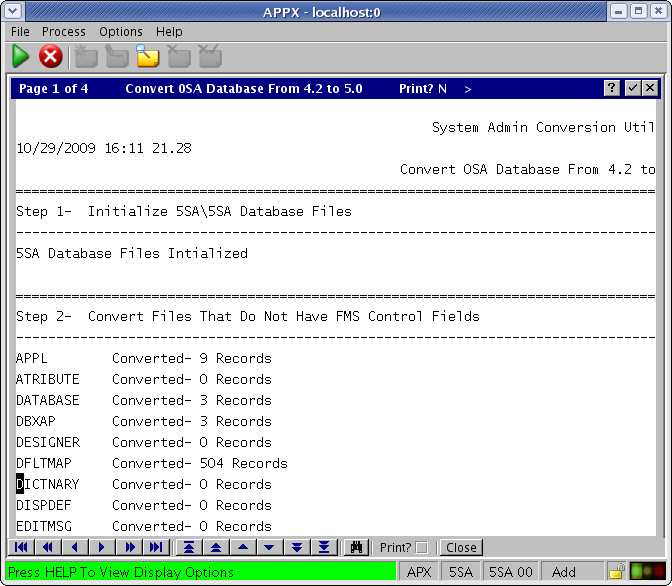
Install the Upgraded System Administration Files | |||||||
| > > | direct RT | |||||||
| Deleted: | ||||||||
| < < | Before you install the APPX Utility, you must first replace your old System Administration files with the new System Administration files that were created when you ran the upgrade utility to convert your System Administration files to the new APPX 5.0.0 structure. You can use a copy command similar to the example below to replace your old System Administration with the upgraded files. Be sure to edit the copy command to reference the directory where APPX is installed on your system if APPX is not installed in "C:\Appx"
COPY C:\Appx\data\5SA\5SA\Data\ C:\Appx\data\0SA\Data\*
If you are prompted to overwrite any files answer Yes or All.
You should also remove the System Administration structure files. You can use a delete command similar to the example below to remove your System Administration structure files. Be sure to edit the command to reference the directory where APPX is installed on your system if APPX is not installed in "C:\Appx".
DEL C:\Appx\data\0SA\Struct\*
You are now ready to install Release 5 on top of your existing installation. Before installing APPX you should:
OverviewTwo different methods are provided to install APPX on Windows. There is a GUI installer and a Console Mode (character mode) installer. Most sites will use the GUI Installer, the character mode installer is intended for sites using Windows Core Server (Windows without a GUI). The same installer is used for both methods. The installer will automatically detect if it is being run as a command or from a GUI Desktop, although in some cases you may have to add "-c" to the command line to force the character installer. Regardless of which installation method is used, the result is the same. A typical APPX installation on a system where APPX has not been previously installed performs the following steps:
GUI Installation on WindowsLog in to your system as an administrative user. Download and run the APPX GUI installer (appxsetup-windows.exe) from the APPX web site or the APPX ftp server. After a few moments, the APPX Setup Wizard should display the Welcome screen. Click on the "Next" button to continue. If you are presented with a Security Warning dialog, click on the "Run" button to continue with the installation.APPX will then be installed into the specified destination directory. Character Mode InstallationIf you are running Windows Core Server, you can run the Appx installer in character mode by appending "-c" to the command line. After a few moments, the Appx Setup Wizard should display the Welcome message. Press Enter to continue the installation.
C:\Appx>setup.exe -c
Unpacking JRE ... Preparing JRE ... Starting Installer ... This will install Appx on your computer. OK [o, Enter], Cancel [c]
Next, read and accept the License agreement. Press Enter as each page is displayed. Please read the following License Agreement. You must accept the terms of this agreement before continuing with the installation. Software License APPX Utility - Release 5.0.0 _ Important! _ Please read this carefully before you click on the Accept button. Definitions: "Software License Agreement (SLA)" shall mean this Software License document and the associated *License Key document collectively. [Enter] After the agreement has been displayed, enter 1 to accept the license agreement, or 2 to cancel the installation. . . . For inquires regarding this agreement, please contact: APPX Software, Inc., 11363 San Jose Blvd., Suite 301, Jacksonville, Florida 32223, USA I accept the agreement Yes [1], No [2] Choose the directory where APPX should be installed and the other installation options. Where should Appx be installed? [C:\APPX] Create a desktop icon? Yes [y, Enter], No [n] Create a Quick Launch icon? Yes [y, Enter], No [n] Install a new APPX 5.x License KeyDouble click the C:\Appx\AppxDesktopClient.exe file to start the Appx Desktop Client. Click on the 'Local' tab, enter the location of the APPX engine (the appx.exe file) and click the connect button. You should be presented with the following System Registration screen. Notice that the Effective Date field on this registration is blank. Starting with APPX 5.0.0, all License Keys include an Effective Date. You must install an updated License Key before you will be able to run APPX 5.x. Note that in Release 5 and higher you can copy your registration to the clipboard, and APPX will detect it when you choose "Typical Import" from the "Import Menu" below.Configure the new APPX Login ManagerAPPX 5 includes the new APPX Login Manager service. This service replaces the Connection Manager (AppxdSvc) which was included with APPX releases prior to APPX 5.0.0. The old Connection Manager will not work with APPX 5 and higher, and should not be used. You should remove the services installed by appxdsvc using the '-remove' keyword: C:\Appx\tools>appxdsvc -remove -name=Appx8060 To configure and start the new APPX Login Manager service, log in as an administrative user and execute a command similar to the following: C:\Appx>CD servicesC:\Appx\services>appxLoginMgr.exe -install -name=appx8060 -displayName=appx8060 -port=8060 -engine=C:\Appx\appx.exe You should see the following messages: appx8060 Created appx8060 Configured appx8060 Started appx8060 will start automatically each time you boot your system After executing the above command, users should be able to use the APPX 5.0.0 Desktop Client to successfully login on port 8060. For additional information on managing APPX Login Services, please refer to the complete documentation. Final Tasks
| |||||||
Comments:Read what other users have said about this page or add your own comments. | ||||||||
| Line: 221 to 142 | ||||||||
|
| ||||||||
| Changed: | ||||||||
| < < | -- SteveFrizzell - 2 Nov 2009 | |||||||
| > > | -- | |||||||
| ||||||||
| Added: | ||||||||
| > > |
| |||||||
View topic | History: r18 < r17 < r16 < r15 | More topic actions...
Ideas, requests, problems regarding TWiki? Send feedback
